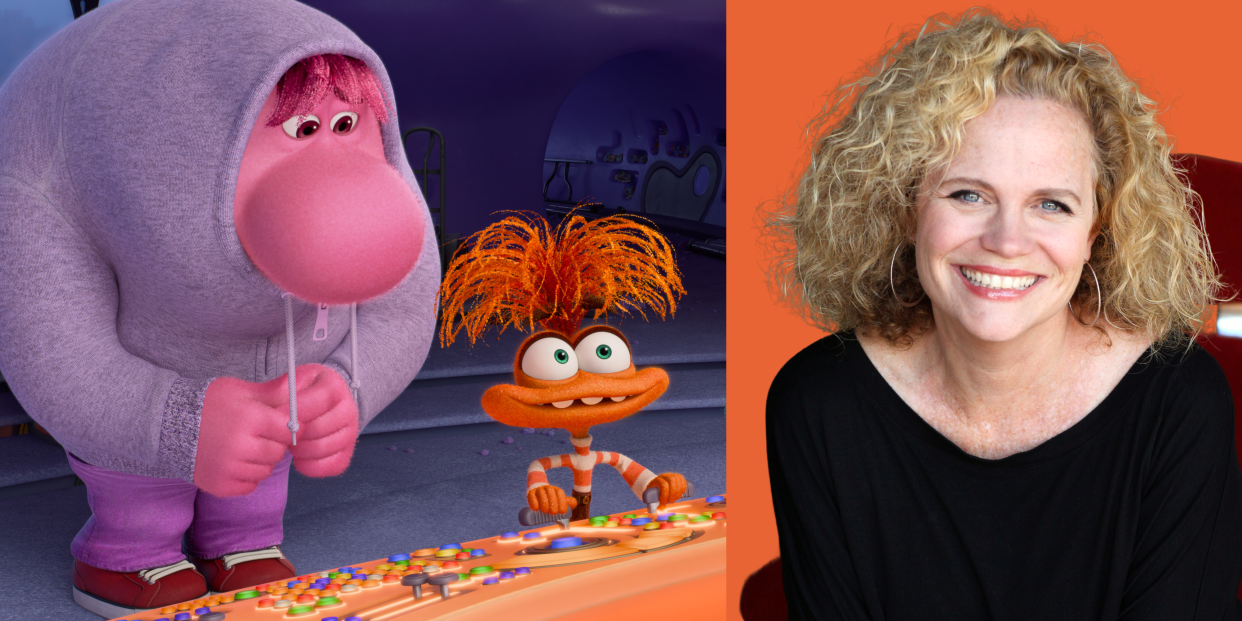‘Inside Out 2’ Writer Meg LeFauve Shares How Her Own Anxiety Helped Inspire the Movie

Walt Disney Studios/Pixar
If you’ve spent much of your life trying to get a grip on your emotions through therapy sessions, self-help books, medications, what have you, you can probably relate to Pixar’s new movie, Inside Out 2, which takes a deep dive into how anxiety and other emotions can make life a little messy sometimes.
SELF recently spoke to Meg LeFauve, who wrote the film’s screenplay, about how her own life influenced the way she portrayed emotions like anxiety and joy, and what she learned from the creative process.
SELF: A lot of people, particularly adults, are saying that Inside Out 2 helped them better understand their anxiety and other complicated emotions. Did you expect these kinds of reactions?
Meg LeFauve: I couldn’t in my wildest dreams imagine this reaction to the movie, I’ll be honest with you—it’s very overwhelming in the best sort of way. Women have been emailing me about feeling stunned in the theater because they felt so seen…. It can bring me to tears.
In the story room, we’re always drawn toward what’s authentic and what feels true to the human experience. It takes a lot of balls in the air to make that happen, but it is always the intention to speak your truth to the audience so that they can receive it and have that catharsis with you.
I want people to know that they’re not alone. You don’t have to worry about everybody else. Your sense of self can come from yourself, not someone’s opinion of you. Those are all really, really important things that I would talk to my friends about, so to have those feelings discussed out in the world is deeply, deeply gratifying and feels a little bit like winning the lottery.
Did you write any scenes in the movie that were inspired by your own life?
For sure. I was a very anxious child. My father used to call me Moody Meg. Nobody understood what was going on with me and there was no language to talk about it, so it was just easier to disappear. And for years, even before I wrote the first Inside Out, when I would have a lot of anxiety—let’s say before I’m going into a meeting to pitch—I would literally just take a breath and imagine a little chair and say, ‘Thank you, Anxiety. I know you’re trying to save my life. I know you’re trying to protect me, but I'm going to be okay. Just take a seat.’ I've done that my whole life because I need to be able to access my joy when I’m telling a story. I can’t have anxiety buzzing in my head.
It was really fun to be able to put that at the end of the movie because it does work for me. I’m not saying anxiety doesn’t exist. She IS there and she IS trying to help me, but, every once in a while, she can step to the side.
You mentioned that adults these days didn’t really grow up with the mental health discussions they needed that many kids now have. Do you agree that this movie is for adults too?
When I was a kid, a favorite parent-phrase was ‘Wipe that look off your face,’ which is basically saying that whatever emotion you’re feeling, don’t feel it. And I understood that, to be fair, my parents didn’t have the training either. There was no language to discuss it at the time. As a parent, it can feel very overwhelming to let your child have the emotion they’re having, bear witness to that, and then hold space for it (which I think is actually harder than fixing it).
So I do think it’s a movie for adults because it’s about people. It’s about being a human in the world. I love that Inside Out 2 is sparking discussions between married people, couples, siblings, and friends, because it’ll help us all to get to know each other better.
Did the creative process for this movie teach you anything about yourself?
I learned many things from this movie, but the one that has impacted me the most is realizing how much my anxiety was trying to help me when I was younger. I used to judge myself a lot, but I learned that my anxiety was, in a way, a gift. She was trying to show me that it’s really about how you use your imagination and whether you let her (anxiety) take the lead or help you to push toward your dreams.
What goals did you have for the primary demographic of this movie (teens going through puberty)?
We had our “Riley’s crew”—teenagers between 12 and 15 years old to help make the movie as authentic to their experiences as possible. They were very prepared and kept us honest.
I understand that Anxiety is getting a lot of attention, as she should, but below anxiety is a very powerful idea about how your sense of self is created by what you believe, and that you have the power to ask, ‘Do I still believe that, and why?’ I think that’s an incredibly powerful idea about being a human that people who watch this movie can discover for themselves. I just want people to be curious about themselves—and all of their emotions—because self-acceptance is so important.
This interview has been edited for length and clarity.
Related:
What Is the ‘Rejection Therapy’ Trend on TikTok, and Will It Really Make Me Less Socially Anxious?
10 Ways to Cope With Anxiety When You’re Feeling Overwhelmed
Get more of SELF's great journalism delivered right to your inbox—for free.
Originally Appeared on SELF


